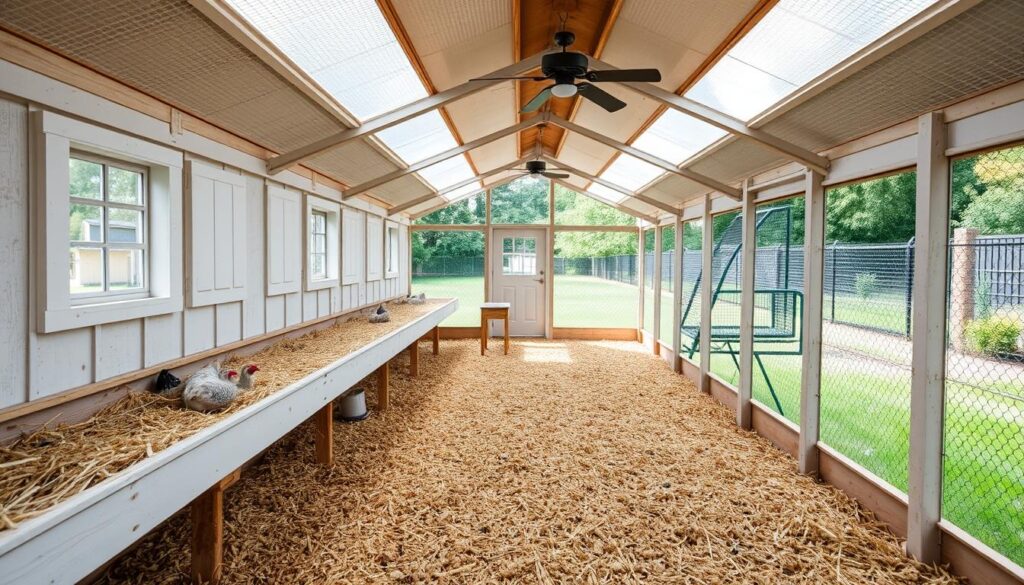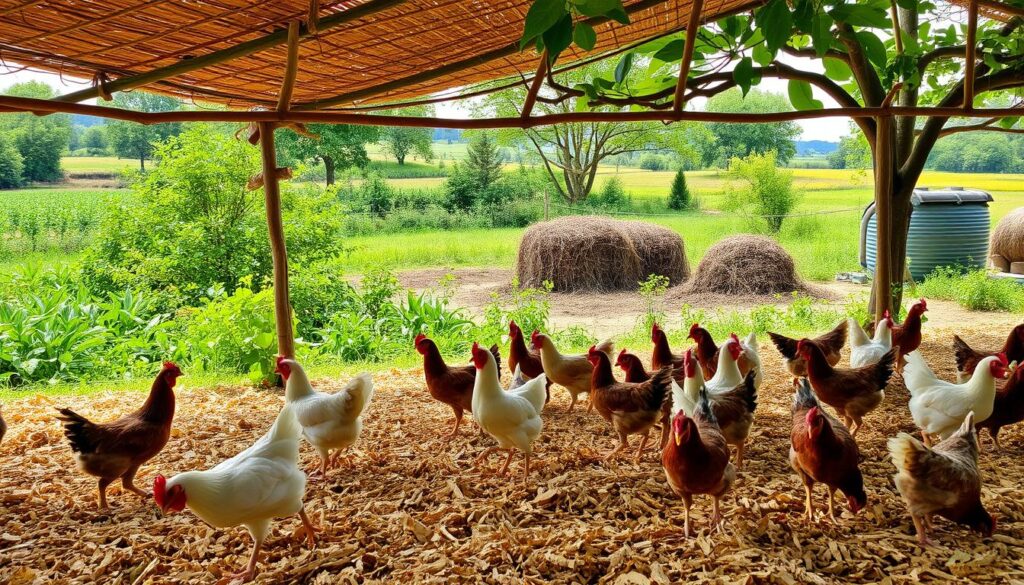
In the world of poultry farming, deep litter housing is a popular choice for raising broiler chickens. It uses a thick bedding layer. This method has both benefits and challenges for broiler production.
Broiler farmers face many decisions about animal welfare, environmental impact, and cost. Understanding the pros and cons of deep litter housing is key.
This article will explore the advantages and challenges of deep litter housing systems. We’ll look at how it affects animal welfare and the environment. Readers will get a full picture of the tradeoffs in using deep litter housing for broilers.
If you’re a broiler farmer or thinking about using deep litter, this article is for you. It aims to give you the insights you need to make a smart choice. By looking at the pros and cons, we’ll help you understand the future of broiler farming better.
Introduction to Deep Litter Housing Systems
Deep litter housing systems are a new way to raise broilers. They offer many benefits for the animals and the farm. The system uses a thick layer of bedding on the coop floor. This layer is comfy for the birds and helps manage their waste.
What is a Deep Litter Housing System?
In this system, the bedding material, like wood shavings or straw, absorbs the manure. Over time, it turns into a nutrient-rich compost. This compost is great for fertilizing the farm.
Benefits of Deep Litter Housing
- Promotes animal welfare by providing a more comfortable and natural environment for the broilers
- Helps to absorb moisture and control odors, creating a more sanitary coop
- Generates a nutrient-rich compost byproduct that can be used to enrich the soil
- Generally less labor-intensive and more cost-effective compared to alternative housing methods
Deep litter housing is a complete solution for raising broilers. It meets the needs of the animals, the environment, and the farm’s efficiency. Knowing its benefits helps producers choose the best housing for their broilers.
The Pros and Cons of Deep Litter Housing Systems for Broilers
Deep litter housing systems for broilers have many benefits. They provide a natural, comfortable surface for the birds, which is good for their feet and health. This system also helps keep odors and manure in check, reducing harm to the environment. Plus, it’s easier to manage and can save money compared to other housing types.
But, there are also challenges. Keeping the litter at the right depth, moisture, and quality is hard work. If not done right, it can lead to high ammonia levels. This is bad for the birds’ lungs and health. Also, starting a deep litter system can cost more than other options.
Before choosing deep litter housing for broilers, think about the pros and cons. The decision should be based on the needs of the birds, the farm’s resources, and the system’s long-term benefits.
| Advantages of Deep Litter Housing for Broilers | Disadvantages of Deep Litter Housing for Broilers |
|---|---|
|
|
Understanding deep litter housing systems helps broiler producers make better choices. They can balance the needs of their birds, farm operations, and environmental impact.
Preparing for Deep Litter Housing
Choosing the Right Litter Materials
Choosing the right litter is key for a deep litter housing system. It must be absorbent to handle moisture and manure. Options include wood shavings, straw, leaves, and agricultural byproducts like corn stalks or peanut shells.
These materials should be dry and high in carbon for decomposition. Avoid hay or aromatic woods to prevent ammonia and harm to chickens.
Setting Up the Coop
The coop’s design is vital for a deep litter system. It needs good airflow and ventilation. Use mesh or perforated walls for air exchange.
An open roof helps draw in fresh air. Sunlight on the litter floor dries and sanitizes it. A cement or brick base around the coop keeps out predators.
The coop should fit the local climate and resources. This ensures a healthy, cost-effective environment for the broilers.
| Litter Material | Absorbency | Decomposition | Suitability |
|---|---|---|---|
| Wood Shavings | High | Good | Recommended |
| Straw | Moderate | Good | Suitable |
| Leaves | High | Good | Recommended |
| Corn Stalks | High | Good | Recommended |
| Peanut Shells | High | Good | Recommended |
| Hay | Moderate | Poor | Not Recommended |
| Aromatic Woods | Moderate | Poor | Not Recommended |

Proper litter depth, 4-12 inches, is crucial. It insulates and helps birds aerate the bedding.
Litter Management in Deep Litter Systems
Keeping the deep litter in good shape is key to a successful setup. Chickens help by scratching and turning the litter. But sometimes, farmers must manually turn the litter to help it break down evenly.
It’s important to keep an eye on the litter moisture and add dry materials when needed. This helps keep the area clean and free of bad smells. Sometimes, adding beneficial microbes through litter inoculation can speed up decomposition and fight off harmful bacteria.
Maintaining the Litter Bed
Creating a deep, well-kept litter bed is vital for broiler chickens’ comfort and health. Regular checks and tweaks to the deep litter quality can stop problems like bad smells or hard litter. Farmers who watch the litter closely can keep their flock healthy and happy.
Monitoring Litter Quality
It’s crucial to check the litter’s quality often. Good litter smells fresh and earthy, showing it’s breaking down well. Keeping it dry, not too hard, and free of bad smells is key. This helps the chickens stay healthy.
Look for signs of litter pathogens or pests, and deal with them quickly. This helps stop diseases from spreading in the flock.
“By closely monitoring litter quality, farmers can ensure the deep litter system continues to provide a comfortable and sanitary environment for their broiler chickens.”
Animal Welfare Considerations
Deep litter housing systems can make broiler chickens’ lives better. The thick litter layer cushions their feet and legs. This helps prevent footpad lesions and other health problems.
These systems let chickens scratch and dust bathe naturally. This makes them happier and healthier. Deep litter systems focus on creating a comfy, engaging space for the birds.
Providing a Comfortable Environment
A study showed that both deep litter and multi-tier systems are good for broilers. They scored well in almost all welfare measurements. The Five Domains Model was used to check their physical, functional, and mental health.
The study was done on two farms in Israel. It found that deep litter lets chickens behave naturally. It also made their feet and bodies healthier.
“The deep, absorbent litter layer can offer better cushioning and support for the chickens’ feet and legs, helping to prevent the development of footpad lesions and other welfare issues associated with alternative housing methods.”
By focusing on deep litter housing animal welfare, producers can improve broiler comfort. This leads to better health and happiness for the birds.
Environmental Impact of Deep Litter Systems
Deep litter housing for broilers is good for the environment. It turns old litter into compost, which is great for soil. This process reduces waste and helps the planet.
The compost from deep litter is full of nutrients. It’s perfect for sustainable agriculture.
Compost and Nutrient Recycling
Farmers can make their farms more eco-friendly by composting. They need at least eight inches of bedding for composting. This keeps the animals warm.
How often to dig out the bedding depends on the animals. Horses need it more often than chickens.
Ammonia Emissions
Deep litter systems can release ammonia. This is bad for air quality. But, there are ways to control it.
Keeping the litter moist and turning it helps. Adding absorbent materials also works. Good ventilation and litter inoculants can reduce ammonia too.
By managing these factors, farmers can enjoy the benefits of deep litter without harming the environment.

Deep Litter Housing for Broiler Production
Advantages for Broiler Growth
Deep litter housing systems are great for broiler chickens. They provide a comfy, insulated space for the birds. This helps them stay healthy and grow well.
The litter’s decomposition creates a rich microbial community. This boosts the chickens’ gut health and disease resistance. It also improves how they use nutrients, leading to better growth and feed efficiency.
Allowing chickens to forage and scratch in the deep litter is also beneficial. It keeps them happy and strong.
Challenges with Modern Broiler Breeds
However, there are challenges with modern, fast-growing broiler breeds in deep litter housing. These breeds are bred for quick growth and high feed efficiency. But they may not forage or scratch as well as older breeds.
This can make managing the litter harder. Farmers need to work extra to keep the litter dry and clean. This is especially true for high-performing breeds.
The deep litter system for broiler production uses materials like hemp and straw. It makes a clean compost heap, saves money, and keeps pests away. It also makes the coop smell better and is easy to clean.
“Improved bird welfare is a significant benefit of the deep litter housing system, allowing birds to engage in natural behaviors and reducing stress-related issues.”
Cost and Profitability Analysis
Deep litter housing for broilers has a big advantage: it’s cost-effective compared to other methods. It saves on construction and operational costs. It also makes managing litter easier, which saves labor. These savings can help small and medium poultry farms make more money.
Also, the compost made from the litter can be sold or used to save money. But, remember to include the cost of litter and any special management needs in your calculations.
By looking at the money side of deep litter housing, farmers can decide if it’s the best choice for their broiler production operations. Here’s a table with important points to think about:
| Factors | Deep Litter Housing | Controlled Environment |
|---|---|---|
| Construction Costs | Lower | Higher |
| Operational Expenses | Reduced | Higher |
| Labor Requirements | Lower | Higher |
| Profitability | Potentially Higher | May be Lower |
By considering these points, farmers can decide if deep litter housing is good for their business. It could help them make more money from their broiler production.
Alternative Housing Systems for Broilers
Deep litter housing systems have many benefits for broiler farming. But, they’re not the only choice for poultry farmers. Other options include battery cages, straw yards, and wire-floored houses. Each has its own good and bad points for animal welfare, the environment, labor, and cost.
Understanding the ups and downs of these alternative broiler housing systems helps farmers make smart choices. For instance, battery cages might be efficient but could be bad for animal welfare. On the other hand, straw yards and wire-floored houses offer a natural setting but need more work and upkeep.
Looking at the pros and cons of deep litter housing alongside these housing system comparison options helps farmers choose the best. By considering animal welfare, environmental impact, and costs, producers can find the alternative broiler housing systems that fit their needs and values.